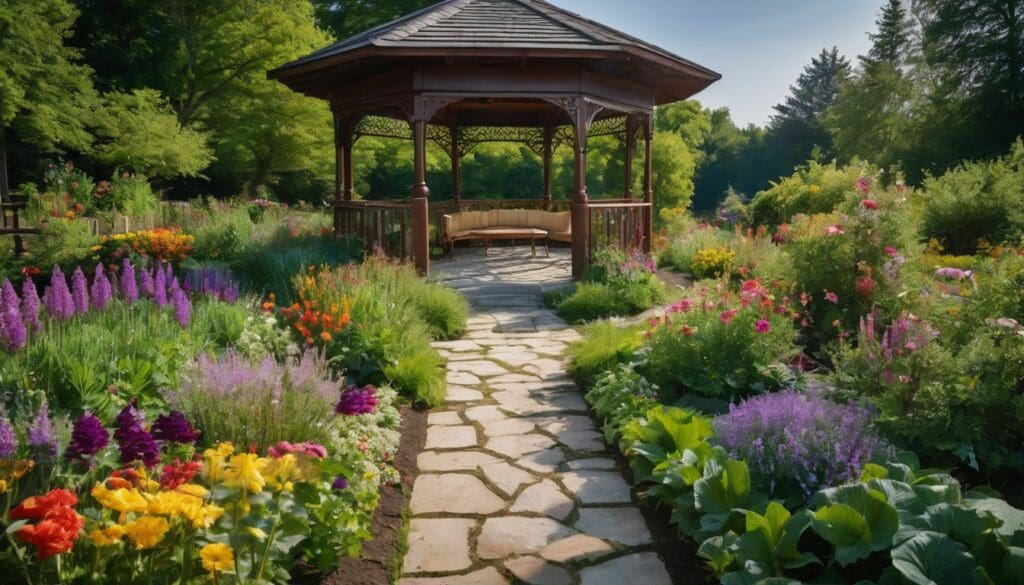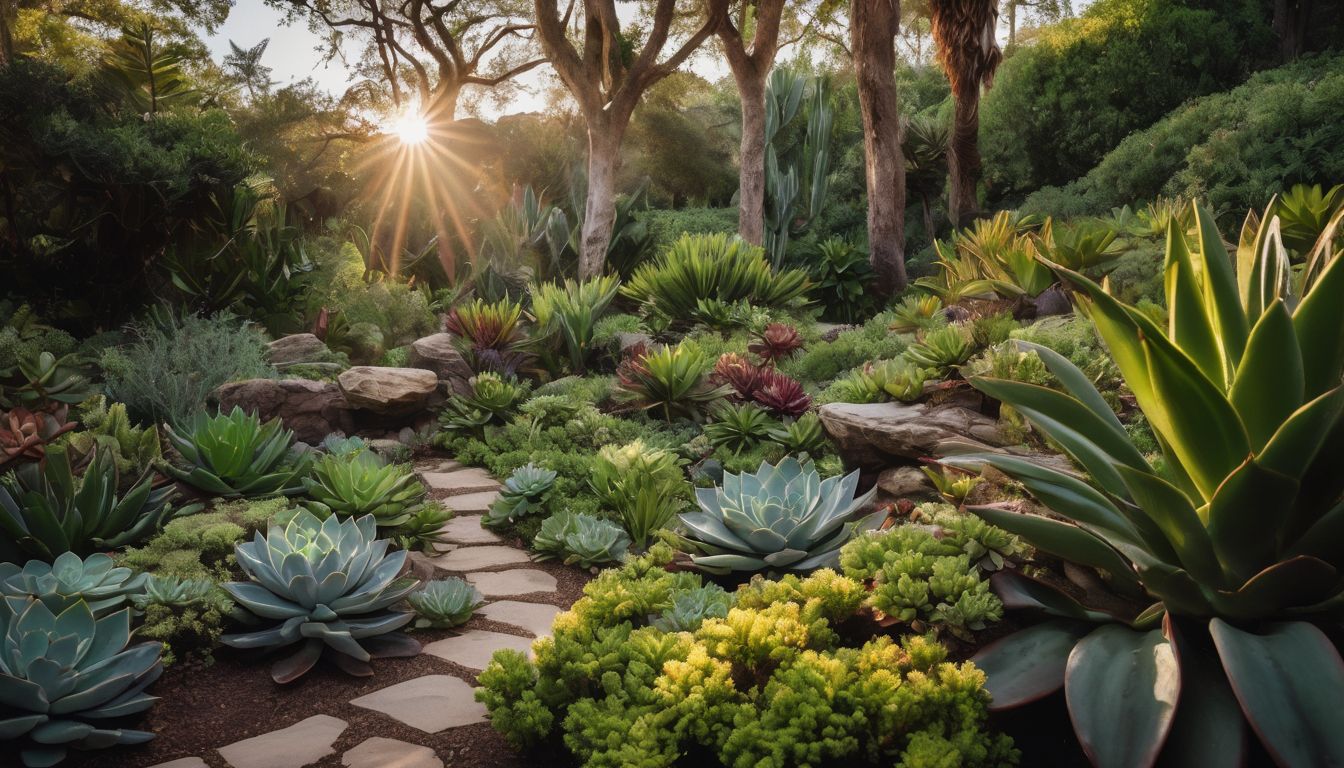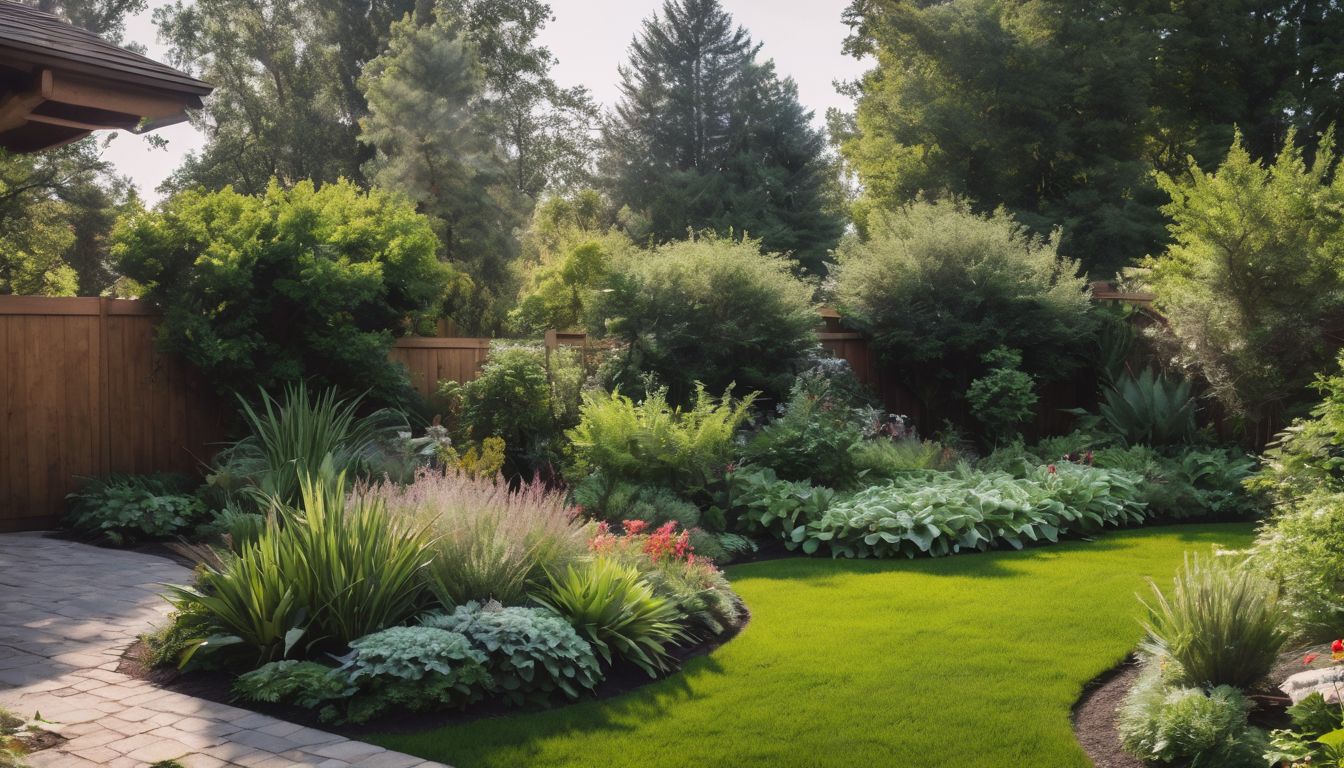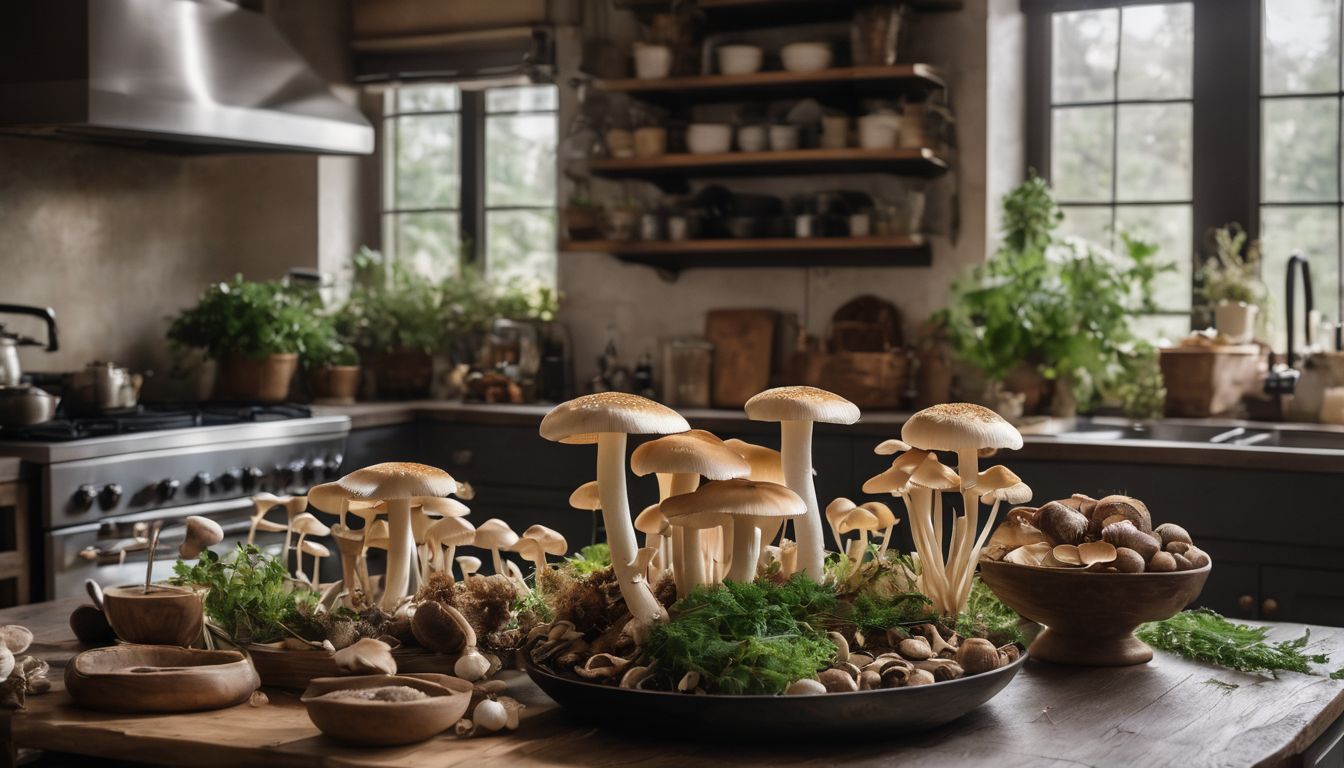Many of us worry about the source and safety of our food. Edible landscaping, a creative blend of beauty and utility, turns ordinary gardens into bountiful food havens. This blog post will guide you through transforming your garden space into a thriving ecosystem brimming with fruits and vegetables.
Discover the delicious world beneath your feet!
Key Takeaways
- Edible landscaping combines the beauty of garden design with practical food growing, where plants like tomatoes team up with roses and herbs outline paths.
- It’s rooted in history, seen in ancient Roman and medieval gardens, and is now part of a broader sustainable living movement.
- Benefits range from health improvements due to fresh produce to economic savings on groceries and increased property values.
- Community gardens and urban farming initiatives are sprouting up, teaching organic practices and building stronger neighbourhood bonds.
- Future edible landscapes will be more sustainable through innovative technology like vertical gardening systems and smart irrigation.
What is Edible Landscaping?
Edible landscaping is the practice of incorporating food-producing plants into residential landscapes for both aesthetic and functional purposes. It has a rich history dating back to ancient times and has become increasingly popular in modern sustainable living practices.
Definition
Edible landscaping merges the beauty of traditional garden design with the practicality of food gardening. Rather than purely decorative plants, this approach emphasises the integration of fruit and vegetable plants into residential landscapes for both aesthetic appeal and sustainable food production.
It transforms an average garden into a place where tomatoes mingle with roses, apple trees provide shade, and herbs form lush borders.
This type of landscaping encourages a harmonious relationship between humans and nature by incorporating agroecology principles into home gardens. Not only does it enhance environmental harmony, but it also supports permaculture practices that contribute to sustainable living.
By choosing diverse crops suited to local climates and employing integrated pest management techniques, homeowners create environmentally friendly spaces that offer fresh produce right at their doorstep.
History
Moving on from the concept of edible landscaping, it’s important to understand its historical roots. The practice of integrating food-producing plants into designed landscapes dates back centuries, with evidence found in ancient Roman gardens and medieval monastic gardens.
Fruit and vegetable gardening has been a longstanding tradition across different cultures, shaping the way we view landscape design today. In recent years, there has been a resurgence of interest in sustainable agriculture and environmentally friendly landscaping, leading to a renewed focus on using urban spaces for food production.
Today, urban agriculture initiatives and community gardens are gaining momentum as people seek ways to create harmonious garden designs that also provide sustenance. This shift towards organic gardening and sustainable gardening practices reflects our growing awareness of the importance of ecological design and horticulture within residential landscapes.
The Benefits of Edible Landscaping
Edible landscaping offers numerous benefits, including improved health from access to fresh produce, economic savings from growing your own food, and environmental benefits from reducing food miles and promoting biodiversity.
Urban farming initiatives and community gardens are also contributing to the spread of edible landscaping across residential areas.
Health benefits
Edible landscaping promotes healthier eating habits, providing access to fresh, organic fruits and vegetables in local communities. Integrating food-producing plants into residential landscapes encourages a balanced diet and reduces reliance on processed foods.
- Boosts consumption of nutrient – dense foods, improving overall health.
- Reduces exposure to harmful pesticides commonly found in non-organic produce.
- Promotes physical activity through gardening and maintenance of edible plants.
- Encourages a sense of community and shared responsibility for sustainable living practices.
- Provides educational opportunities for children and adults about the origin and benefits of fresh produce grown at home.
Economic benefits
Switching focus from health benefits to economic advantages, edible landscaping can significantly reduce your grocery bill. Many homeowners have seen a reduction in food costs by growing their own produce. Here are the economic benefits of edible landscaping:
- Food savings: Growing your fruits and vegetables can lead to substantial savings on grocery expenses, making a positive impact on your household budget.
- Increased property value: Edible landscaping can enhance the market value of your property, offering a return on investment when it’s time to sell or rent out your home.
- Job creation: The growth of urban farming and community gardens can stimulate local economies by creating opportunities for employment and entrepreneurship in sustainable agriculture.
- Reduced food miles: By producing food on-site, you’ll diminish the need for transportation and lessen the associated costs, contributing to reduced carbon emissions and energy conservation.
- Waste reduction: The reduction of food waste through homegrown produce results in additional savings by reducing trips to the grocery store and lessening potential disposal costs.
Environmental benefits
- Conserves water: Edible landscapes typically require less water than traditional ornamental gardens, contributing to water conservation efforts and reducing overall water usage.
- Improves air quality: Food-producing plants help in offsetting carbon emissions and enhancing air quality by absorbing pollutants from the atmosphere.
- Supports local ecosystems: By incorporating native edible plants into landscaping, it fosters biodiversity and provides habitats for beneficial insects and wildlife.
- Reduces food miles: Growing food on your property reduces the need for transportation, thereby lowering greenhouse gas emissions associated with long-distance food distribution.
- Minimises chemical use: Edible landscapes tend to be managed using organic methods, decreasing reliance on synthetic pesticides and fertilisers that can harm the environment.
- Mitigates urban heat island effect: The cultivation of edible plants in urban areas helps to lower temperatures by providing shade and greenery, mitigating the urban heat island effect.
- Promotes sustainable land use: Converting traditional lawns into productive foodscapes reduces the ecological footprint associated with maintaining non-functional turf grass.
Case Studies
Explore how community gardens and urban farming initiatives have successfully integrated edible landscaping into their design, providing not only fresh produce for the local community but also fostering a sense of community engagement and environmental stewardship.
Community gardens
Community gardens are thriving spaces in urban areas where people come together to grow fruits, vegetables, and herbs. These communal green oases create a sense of belonging and promote sustainability by reducing the carbon footprint associated with food transport.
By taking care of these shared plots, individuals can learn about organic farming practices while fostering a stronger connection to nature. These projects contribute significantly to local food security and provide an excellent opportunity for individuals to engage in environmentally friendly activities right in their neighborhoods.
Urban agriculture initiatives support community resilience and have been proven as effective strategies for promoting social inclusion while enhancing local biodiversity. The positive impact of such gardening ventures on mental wellbeing cannot be overstated, providing opportunities for urban dwellers to reap both physical and emotional benefits from participating in growing nutritious produce collectively.
Urban farming initiatives
Transitioning from community gardens to urban farming initiatives, the trend of edible landscaping has sparked interest in sustainable practices within urban environments. Urban farming initiatives involve cultivating food-producing plants within city limits, utilising even small spaces for sustainability and local food production.
Such initiatives not only promote access to fresh produce but also foster a sense of community involvement and ecological responsibility.
By integrating technology and innovative solutions, urban farming initiatives aim to address issues like food security and environmental impact while promoting a healthier lifestyle.
The Future of Edible Landscaping
The future of edible landscaping lies in its sustainability and the integration of technology and innovation. As more people become aware of the benefits and potential of food-producing plants in residential landscaping, we can expect to see a rise in the popularity of foodscaping as a sustainable practice.
Sustainability
Sustainability in edible landscaping is crucial for supporting conservation and environmental efforts. By growing food-producing plants within residential landscapes, individuals can reduce their carbon footprint and contribute to local food production.
Sustainable landscaping also promotes the use of organic practices, minimising chemical inputs that can harm the environment. This approach fosters a holistic understanding of the interconnectedness between humans and nature, encouraging responsible stewardship of land resources.
Moreover, sustainable landscaping encourages biodiversity by providing habitats for pollinators and beneficial insects essential for ecosystem health. As more people embrace foodscaping techniques, they not only ensure a more resilient future but also foster a greater appreciation for the natural world around them.
Technology and innovation
Innovative technology plays a vital role in the future of edible landscaping. Advancements such as precision farming techniques, vertical gardening systems, and smart irrigation solutions are revolutionising food production in urban areas.
These innovations not only maximise limited space but also optimise resource use, making it easier for environmentally conscious individuals to grow their own food sustainably. Embracing these technological advancements can help create a more sustainable and self-sufficient approach to food production while supporting conservation efforts.
Looking ahead, the integration of technology into edible landscaping will continue to empower individuals and communities to cultivate their own fresh produce in an eco-friendly manner.
Conclusion
Embracing edible landscaping can benefit both individuals and the environment. Communities can flourish through shared gardens and urban farming initiatives. Sustainable practices and innovative technologies will continue to shape the future of this growing trend.
As more people recognise the value of food-producing plants, the landscape of our surroundings may increasingly become a source of nourishment.
FAQs
1. What is edible landscaping?
Edible landscaping combines gardening with the trend of growing food-producing plants in your garden to make spaces both beautiful and practical.
2. Can anyone try edible landscaping?
Yes, anyone can start adding food-producing plants to their gardens, no matter how big or small their space is.
3. Do you need special seeds for edible landscaping?
You don’t need special seeds; just choose your favorite vegetables, herbs, or fruit plants that will grow well in your climate.
4. Is edible landscaping good for the environment?
Absolutely! Edible landscaping not only provides fresh produce but also supports local wildlife and reduces the ecological footprint of transporting food.





